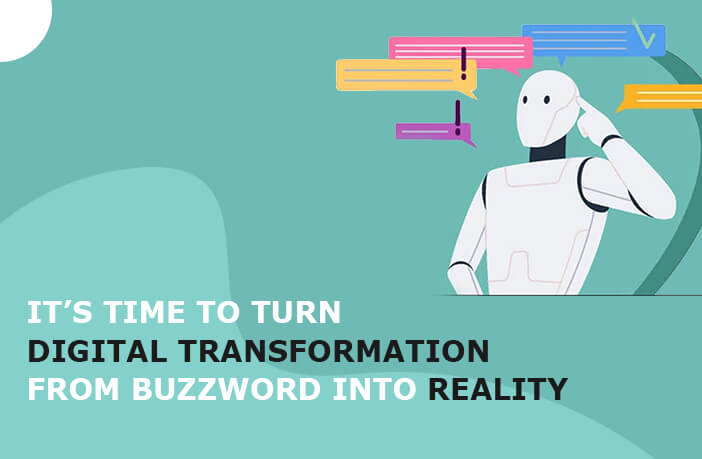It’s time to turn digital transformation from buzzword into reality!

In the last year, the economy, health, and social interactions have taken a dip. We are forced to conduct everything we do online, whether it’s work calls or grocery shopping. Our society has yet to fully recover from the pandemic, but we can now look back and see the dramatic pace of change seen in the past year and a half, as well as how businesses were able to adapt to a new normal. Consequently, many businesses doubt that it is possible to go back to their previous ways of working.
Digital transformation is rife with overused and vague buzzwords. All kinds of buzzwords are created in the ERP technology and digital transformation industry. As a result, it’s fundamentally a method of expressing value and a way to express oneself differently.
Each company’s view of digital transformation can differ. It is impossible for companies to see the true potential of this revolutionary technology and the reasons why it is so crucial to living in the modern world just to survive. Let’s take a closer look at the true meaning of digital transformation and why you’ll run the risk of losing your business if you don’t take it seriously!
We live in a world where digital technology has fundamentally changed our lives. A profound transformation has taken place, with ways of interacting, talking, meeting, and engaging with each other totally transformed.
Digital Transformation Driver: Survival
The term digital transformation drivers will suffice for this section on digital transformation drivers. Many companies are focusing heavily on the digital transformation path to keep up with (and even outpace) competitors, incumbents, and new entrants into their sectors. Companies are striving to replace inefficient machinery with more effective ones in order to improve productivity. Companies that refuse to adapt will eventually degrade. The digital revolution has now touched every business, every executive, and every entity. There are three options for businesses to consider: either being adversely impacted, monitoring the disturbance, or leading the disruption.
What is Digital Transformation about?
- Enhancing business value, not just streamlining business processes
The use of digital technologies alone is not enough to reduce costs and speed up processes. Cloud-based Office 365 is not digital transformation if you are migrating from your own Microsoft Exchange server. In other words, this is the same email you had before.
- High-velocity time-to-market
Business modification is largely influenced by speed. When systems take months or years to implement, business requirements often change by the time they are implemented. This means problems have to be faced earlier. Conceptualization to the closure of digital transformations takes weeks or days.
- Agile development methods
The traditional method of developing a business is through a “waterfall”. Businesses submit requirements, IT codes, and tests to IT, but IT provides systems that do not resolve the business issue months or years after the issue was raised. Ineffective waterfall development may be caused by the problem of business users rarely being able to express their requirements clearly. They’re operating with current systems and adjusting them regularly until they’re just right. Steve Jobs said, “The customer shouldn’t have to know what they want.” Rearranging furniture is the same thing. If it does not work in a particular place, then you can move it around until it’s perfectly positioned, or, you can try switching it around until it works.
- Digital transformation tools are a pleasure to use
Digitization is becoming increasingly important because it pits the IT sector against businesses whose products consumers really like. Instagramming and Facebooking are popular ways to pass the time on weekends and evenings. But when they get to work, they find it difficult to complete corporate invoices. IT fails to meet the challenge. The idea of having a business invoicing system that is enjoyable to use is out of reach.
- Automation
To effectively transform an organization, platforms and tools must be implemented that automate management, and free up monetary resources and personnel to do work that adds value to the organization.
- Crossing business and technology lines
In order to achieve digital transformation, IT collaborates with company users to build systems that meet their needs.
- Leveraging emerging technology
The Internet of Things, microservices, open-source, artificial intelligence, machine learning, and containers are among the tools used in digital transformation to achieve its goals. A mainframe running Windows XP is an ideal environment for using COBOL programs for digital transformation.
- Connecting partners and customers
There is no justification for IT to develop systems for co-workers; consumers, distributors, contractors, and other associates will benefit as well.
Conclusion
Digital transformation is a relatively new buzzword, but its roots go further back than many people realize. In the ’90s, we heard about the need for IT to increase business importance by using Internet technologies. Now, we hear about how critical IT is to increasing business productivity. The retail, hospitality, and cab industries are all examples of what happens when incumbents fail to adopt the digital transformation that would allow them to compete with Amazon, Airbnb, Uber, and Lyft.
Overall, the digital transformation process is complex and multifaceted, but it is a requirement for businesses that want to stay competitive. Additionally, it is a continuous process since technology is constantly evolving and all the systems require maintenance and training. Lastly, as the business grows, you may need to scale all the systems and add new processes.


















